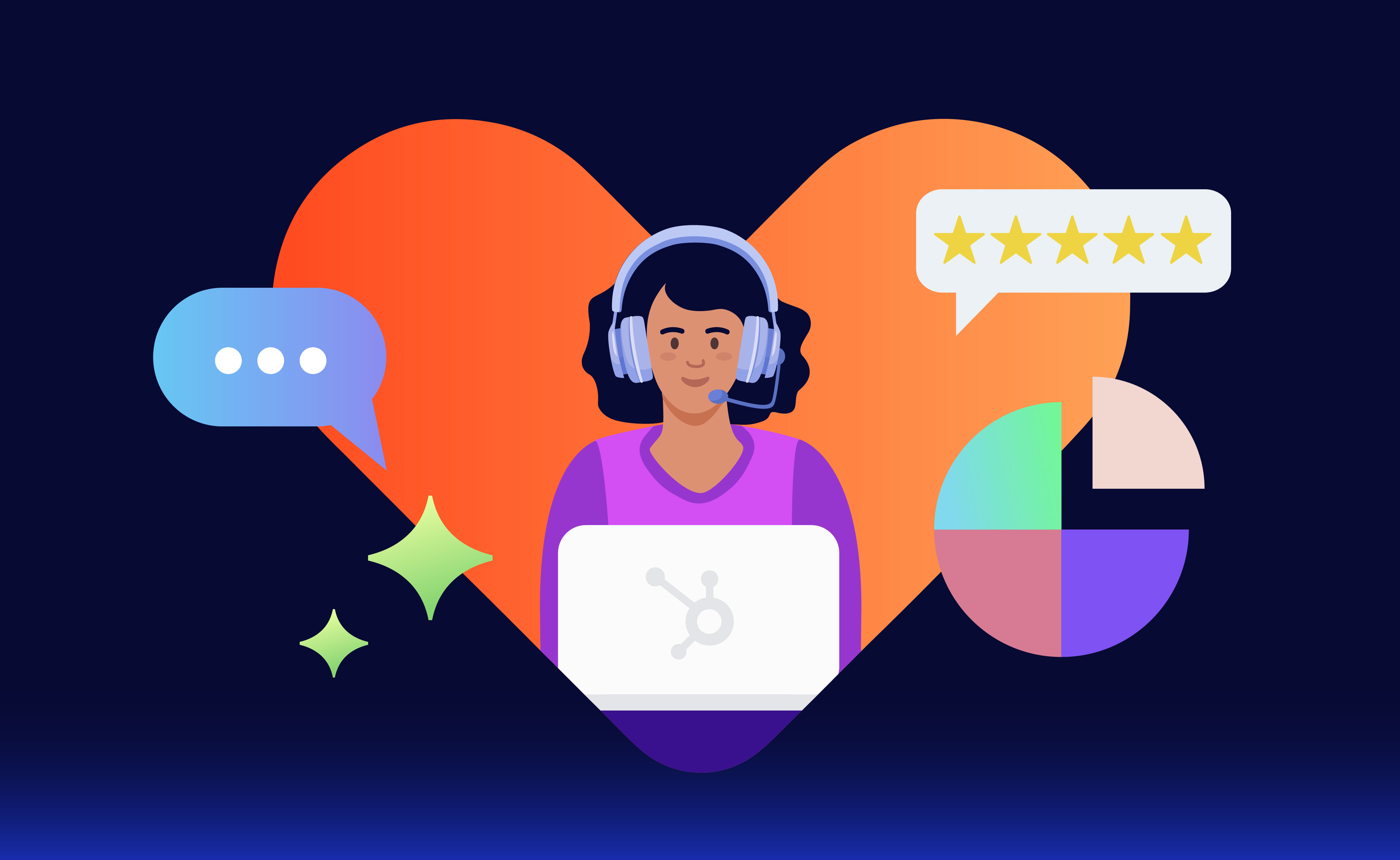AI & The Customer Journey: Insights from HubSpot's Inbound 2023 Conference
Approx 4 min. read
.jpg)
This year, Ever Wonder attended HubSpot's Inbound 2023 Conference.
We attend Inbound every year, with presentations focused on a variety of marketing trends and topics.
But this year was different. One theme wound its way through the entire conference: AI.
It's no secret that AI has changed the world, and a disproportionate amount of that change has hit marketing. After all, much of what we do involves writing, and that's precisely what Large Language Models (LLMs) do.
We'd like to share some of the most important ideas from three key speakers at the conference:
- Yamani Rangan, who explained how AI is changing the customer journey.
- Andy Pitre, who introduced HubSpot AI.
- Dharmesh Shah, who presented ideas about the future of AI in marketing.
Yamani Rangan: How AI is Changing the Customer Journey
.jpg?width=648&height=398&name=EVER_Muse_HubspotSpotlight_v1__inline_1%20(1).jpg) As Yamani pointed out in her talk, more change has happened in marketing over the last 9 months than most industries have seen in the past 9 years. Her presentation focused on making sense of those shifts, as well as how marketers should evolve in response.
As Yamani pointed out in her talk, more change has happened in marketing over the last 9 months than most industries have seen in the past 9 years. Her presentation focused on making sense of those shifts, as well as how marketers should evolve in response.
In her opinion, the Age of Information is giving way to the Age of Intelligence.
Having a wealth of consumer data at our fingertips is no longer enough. We must also leverage intelligence to drive customer connection. Connection matters because it drives growth. According to HubSpot's research:
- Companies that drive connection grow 5X more than the average company.
- Connecting consistently throughout the customer journey leads to 19% more growth.
-1.jpg?width=4750&height=2917&name=EVER_Muse_HubspotSpotlight_v1__inline_2%20(1)-1.jpg)
While customer connection has always been important, it has always been expensive and time-consuming. But now AI can drive connection at scale, and through all four stages of the customer journey.
- Discovery
- Consideration
- Buying
- Use
Discovery is shifting from search to social. For decades, consumers went to Google when they were looking for a product. Now, 44% of buyers use social media as their primary source for discovering new products.
Consideration is shifting from clicks to conversations. People don't simply want to convert on a web page. They want to converse about the product they see.
Buying is shifting from personalized to personal:
- Personalized interactions are templated—organized around the demographics that a buyer is believed to represent.
- Personal interactions, on the other hand, are much deeper. They are based on insights specific to the exact person.
Finally, use is shifting from reactive to proactive.
The buying journey doesn't end when a customer swipes their credit card. In a way, that is only the beginning. At the very least, businesses need to provide responsive help in the form of customer service and help desks.
However, it is far better to provide proactive assistance in the form of personal recommendations, suggestions, and solutions to problems you anticipate they will have.
Andy Pitre: Introducing HubSpot AI
.jpg?width=1152&height=708&name=EVER_Muse_HubspotSpotlight_v1__inline_3%20(1).jpg) The core of Andy's speech was the introduction of HubSpot AI, HubSpot's new AI-driven marketing platform.
The core of Andy's speech was the introduction of HubSpot AI, HubSpot's new AI-driven marketing platform.
HubSpot AI is integrated with existing HubSpot software, meaning it has access to important information that other AI systems don't have by default: it knows your content, your customers, and your business.
New features include:
- AI Assistants
- AI Agents
- AI-driven Insights
- AI Chatbots
HubSpot AI helps businesses make the transitions mentioned by Yamani Rangan in her talk about the 4 stages of the customer journey.
For the discovery phase, HubSpot AI offers these tools:
- Content Assistant, which creates images from text content.
- Campaign Assistant, which generates landing pages, ads, and more.
For the consideration phase, HubSpot AI offers two new tools:
- ChatSpot, for putting a live chatbot on your website. It reads all of your content to learn and understand your business.
- SMS integration into HubSpot for better customer connection.
For the buying phase, HubSpot AI offers two new features:
- Sales Hub, which enables teams to automate key sales tasks, uncover crucial insights, and personalize interactions.
- AI Forecasting, which uses company data to forecast sales.
For the use phase, HubSpot AI offers several features:
- Service Hub, which empowers your service team to deliver personalized support and key insights to drive customer loyalty.
- Support Assistant, which helps service reps write better messages with the right length and tone.
- A single source of truth for support, sales, and marketing.
Dharmesh Shah: The Future of AI
.jpg?width=1152&height=708&name=EVER_Muse_HubspotSpotlight_v1__inline_4%20(1).jpg) Dharmesh is clearly infatuated with AI. He spent much of his presentation talking about how he fell in love with the technology, and explaining why you should too.
Dharmesh is clearly infatuated with AI. He spent much of his presentation talking about how he fell in love with the technology, and explaining why you should too.
But the real takeaway of his talk is his thoughts on where our relationship with AI is heading.
To see this, Dharmesh pointed out the common frustrations that people have with the present state of AI, as well as how they will change:
- Large Language Models, or LLMs, are static. They are trained on a set of data that is fixed one day and don't know about anything that happens afterward.
- LLMs also rely exclusively on text input. You cannot yet give ChatGPT a picture and ask it questions about the picture.
- Finally, LLMs are passive—they react to your instructions, instead of going out in the world and acting upon their own accord.
Dharmesh believes that all these problems are due to change in the future. Instead of being static, passive, and text input-only, future AI systems will be dynamic, active, and rely on multi-modal input.
These changes will combine to give rise to the next big wave in AI, which he calls AGENT AI:
- Autonomous
- Goal-oriented
- Expert
- Networked
- Tailored to users
An example of an Agent AI would be a prospecting agent—a program that crawls the web searching for likely prospects for your business.
Conclusion: AI is in the Details
Although AI is definitely causing a bewildering amount of change in the marketing world, it's important to take a step back and realize where these changes are actually taking place.
Clearly, AI hasn't taken all of our marketing jobs yet. And none of the presenters suggested that it would.
At most, Dharmesh suggested that it would take your job and give you a better one in return.
What AI is really doing is enhancing the level of detail involved in marketing work. Marketing is becoming more fine-grained and personal, at scale, thanks to the power of AI.
This means greater efficiency and precision in sales and marketing operations. While AI tools may make it easier to deliver a high quantity of communications, the marketers who stand out will also use them to deliver a higher quality of communication.
Related posts
Food for thought.

Empower Customer Success with HubSpot’s AI-Powered Service Hub
by Conor Ebbs

How to Collect Customer Feedback And Use It To Craft Your Company Vision
by Balogun Olabode Jr